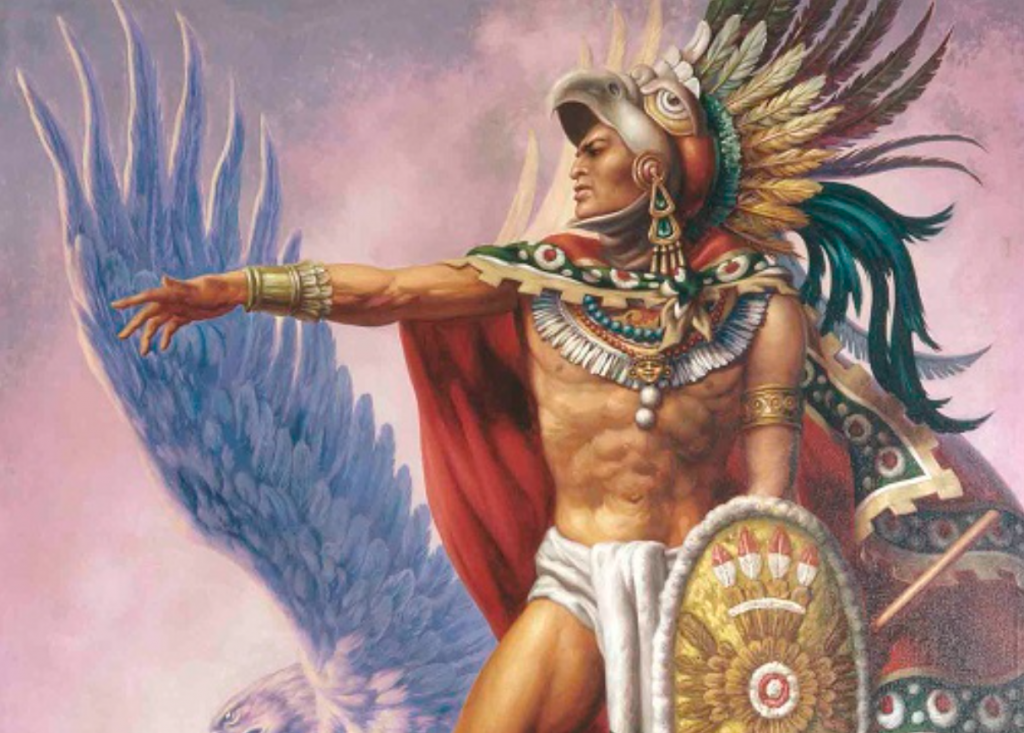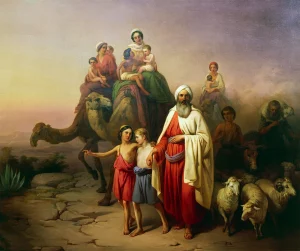Cuauhtémoc, although murdered in defeat, left a legacy as the last Aztec emperor who led Tenochtitlan in defense against Hernán Cortés and the Spanish invaders. The young warrior was initially selected to serve as emperor because of his fierce opposition to the Spanish invasion, which greatly appealed to the majority of the empire. Moctezuma II, who reigned during the first invasions of the Spanish, lost the support of his people, whereupon they publicly executed him for submitting and complying with the Spaniards.1 Moctezuma’s successor, Cuitlahuac, attempted a united resistance against the colonizers, but proved unsuccessful following his unexpected smallpox-related death only eighty days after beginning his reign.2 The last and final tlatoani, or emperor, was the young and vigorous Cuauhtémoc, whose assumption of power was supported by a political motivation to organize against the Spanish. Having been related to the past two tlatoani, holding significant connections to the neighboring Mexica district of Tlatelolco, his fierce and public opposition to the Spanish, and continuing the resistance against the colonizers laid by his predecessor Cuitlahuac, provided promise and assurance of Aztec survival. These characteristics made young Cuauhtémoc the obvious choice among the highest noblemen, and so he became selected to lead Tenochtitlan in 1520.3 Although the young tlatoani had promising factors working in his favor, the Spanish forces prevailed, leading to the recognition of Cuauhtémoc as the last Aztec emperor. What followed was the colonization of the Aztec people that would transform the Mexica area forever.

Cuauhtémoc’s predecessor, Cuitlahuac, had spent his eighty-day reign defending the empire from Hernán Cortés, and proved unsuccessful except for a minor victory where he drove out the Spaniards on the Noche Triste in July of 1520.4 Amid the death of Cuitlahuac and the inauguration of Cuauhtémoc, Cortés strategized an attack against Cuauhtémoc’s Tenochtitlan in response to the Spanish Night of Sadness. As part of his militaristic plan, Cortés captured the smaller neighboring city Tlaxcala, where he forced its people to aid in the upcoming destruction of the Aztec capital Tenochtitlan.5 Dramatically denying Cortés’ offer to surrender, Cuauhtémoc issued a decree to sacrifice all those who sympathized with the Spanish, especially those who converted to Christianity, to the Aztec gods as a jab to Cortés’ presence and as a threat to any of his people who would dare aid in Cortés’ conquest.6 The first attack on Tenochtitlan came in March 1521, where Cortés had taken control of a nearby valley, the Valley of Mexico, and was able to gain alarming ground until Cuauhtémoc met the Spanish forces with his own forces. Deploying his land and naval forces, Cuauhtémoc pushed back and interrupted Cortés and his indigenous allies.7 However, this small victory was not enough to completely remove the Spaniard and Tlaxcala armies from the periphery of Tenochtitlan. After retreating back through the Valley of Mexico, Cortés quickly received reinforcements from Hispaniola, and once again held the upper hand in the back-and-forth war with the Aztec tlatoani. Only a month later, Cortés penetrated himself into the borders of Tenochtitlan, where Cuauhtémoc was left vulnerable and desperate. The years of military preparation, heroic legacy, and the royal bloodline of Cuauhtémoc were desperately called on in these moments of siege, in order to protect his people. As Cortés’ forces were inching closer and closer to the streets of the capital, Cuauhtémoc directed his warriors in the same direction. Knowing that the Spanish had militaristic advantages, such as a cavalry force, the tlatoani depended on his soldiers’ knowledge of the intricate grounds of Tenochtitlan, providing a temporary success when the Spanish were forced to retreat and leave the capital.8 To no surprise, Cortés met Cuauhtémoc’s advances with his own and delivered a detrimental blow by seizing Aztec food supplies and brutally starved the city until the tlatoani responded with his own move.9 In a final unified attempt, Cuauhtemoc called on his Mexica neighbors to aid in the fight against the white man that had continued for almost three months.10 At this point, Hernán Cortés had conquered much of the Mexica region, leaving only Cuauhtémoc’s earliest ally, Tlatelolco, as reinforcements.11 The tlatoani was out of militaristic strategies and was edging toward defeat. While most of his Tenochca people began fleeing to Tlatelolco, he marked the end of his war against the Spaniards by attempting to flee his city, but was ultimately captured by his enemy.12 Upon his capture, Cuauhtémoc requested to be killed at the hands of Hernán Cortés, which could have been an act to save his honor or to please the Aztec gods, but Cortés refused and cited his country’s respect for bravery and valor, even in an enemy.13 The mercy from Cortes was short-lived and ended when it came time to question Cuauhtémoc about the riches and resources of his empire. Facing torture, Cuauhtémoc remained quiet and restricted when interrogated about the gold rumored to be hidden in the Tenochtitlan empire. Cortés responded to the captured emperor’s silence by gruesomely burning the soles of his feet to invoke a break of information. While Cortés committed acts of terror in the name of greed and hegemony, Cuauhtemoc remained loyal and sacrificial for the sake of his empire and its riches.14 One could say he remained enduring because of his commitment to the Aztec gods and his adversary to the long-hated Spanish colonials. This encounter of punishment and persecution would be one of the last moments Cuauhtémoc would experience in his Mexica home before he was imprisoned by Spanish officials and stripped of his power.

Following the capture and torture of the emperor, Cortés forced Cuauhtémoc to serve under his command in exchange for his life. By 1525, Cuauhtémoc was brought along in Cortés’ expedition to Honduras, and there is debate on whether he was regarded as a Spanish soldier or as a Spanish slave.15 Since Cortés had expressed concern about the possibilities of Cuauhtémoc leading a revolt in his absence, it is easier to believe the latter on Cuauhtemoc’s status. The relationship between Cuauhtémoc and Hernán Cortés was passive-aggressive, to say the least, because of Cortés’ attempts at mercy that would be met almost immediately with reprimands against the emperor. For example, Cortés agreed to allow the defeated people of Tenochtitlan to leave the city after the capture of the emperor. Although they left physically unharmed, Cortés left them psychologically crippled when he forcibly converted Cuauhtémoc to Christianity and undermined their relationship to Huitzilopochtli, the Aztec god. Cortés gave Cuauhtémoc a quasi-credible status when he baptized him into Christianity, calling him the Christian name Fernando Cuauhtémotzín, but reminded him of his powerlessness by allowing the tlatoani to keep the title but hold absolutely no reign over his own people.16 Although beaten, captured, and patronized, Cuauhtémoc did not accept complete defeat and remained determined throughout the Spanish expedition to Honduras. Cuauhtémoc, along with other captured noble Aztecs, plotted to assassinate Cortés mid-expedition as an attempt to tip the power back in the Aztecs’ favor. Betrayed by one of their own, a member of the Mexica people informed Cortés about the plot to assassinate him. After heavy interrogation and remembrances of his burning torture years earlier, Cuauhtémoc and his allies were condemned to death for their acts against Cortés. In an account provided by Spaniard Bernal Diaz de Castillo, who worked closely under Cortes, Cuauhtemoc shouted his last words to the conquistador:
Now I understand your false promises and the kind of death you have had in store for me. For you are killing me unjustly. May God demand justice from you, as it was taken from me when I entrusted myself to you in my city of Tenochtitlan! 17
Signifying the ultimate end of the great Aztec empire, Cuauhtémoc was hung alongside a fellow nobleman for planning to assassinate a Spanish official. In Diaz del Castillo’s accounts, Cortés felt overwhelming guilt for executing the Aztec man who was deeply revered even in bondage.18

Perhaps questioning the treatment he gave the emperor, the colonization of a whole people, the undeserving death of the tlatoani, or all of these factors made Cortés suffer from mental and health problems following Cuauhtémoc’s hanging.19 The name Cuauhtémoc, meaning descending eagle in Nahuatl, provided duality to the tlatoani in his lifetime. He began as a young emperor whose tactics and military persona mirrored an eagle plummeting to the ground to attack and capture its prey. His life ended and his namesake symbolized the death he endured like an eagle sinking to the floor after being brought to death abruptly mid-flight. While the majority of his life was centered around the tumultuous and emotional fight to protect the Aztec and Mexica people, his death marked a significant turning point for the nation and its future. Although the Aztec empire continued after the death of Cuauhtémoc, the few and insignificant years were no match for the ultimate and complete colonization of the Spanish.
The end of the noble tlatoani Cuauhtémoc of Tenochtitlan marked the end of his great empire and the beginning of Spanish imperialism that would change the Mexica people and their country forever. Revered in life and in death, Cuauhtémoc has remained a symbol of indigenous power and honor in today’s Mexico.

- Encyclopaedia Britannica, 1998, s.v. “Cuauhtemoc.” ↵
- Domingo de San Anton Munon, Chimalpahin, Codex Chimalpahin: vol 1 Society and Politics in Mexico Tenochtitlan (University of Oklahoma Press, 1997), 56-57. ↵
- The Oxford Encyclopedia of Mesoamerican Cultures, 2001, s.v. “Cuauhtemoc” by Miguel Leon-Portilla. ↵
- Bernal Diaz del Castilo, Historia verdadera de la conquista de la Nueva Espana (Penguin Books, 1963), 234. ↵
- Bernal Diaz del Castillo, Historia verdadera de la conquista de la Nueva Espana (Penguin Books, 1963), 303-305. ↵
- Jim Tuck, “Cuauhtemoc: winner in defeat (1495-1525)” MexConnect, October 9, 2008, https://www.mexconnect.com/articles/260-cuauhtemoc-winner-in-defeat-1495-1525/ ↵
- Jim Tuck, “Cuauhtemoc: winner in defeat (1495-1525)” MexConnect, October 9, 2008, https://www.mexconnect.com/articles/260-cuauhtemoc-winner-in-defeat-1495-1525/. ↵
- Jim Tuck, “Cuauhtemoc: winner in defeat (1495-1525)” MexConnect, October 9, 2008, https://www.mexconnect.com/articles/260-cuauhtemoc-winner-in-defeat-1495-1525/ . ↵
- Jim Tuck, “Cuauhtemoc: winner in defeat (1495-1525),” MexConnect (website), October 9, 2008, https://www.mexconnect.com/articles/260-cuauhtemoc-winner-in-defeat-1495-1525/ ↵
- The Oxford Encyclopedia of Mesoamerican Cultures, 2001, s.v. “Cuauhtemoc” by Miguel Leon-Portilla. ↵
- The Oxford Encyclopedia of Mesoamerican Cultures, 2001, s.v. “Cuauhtemoc” by Miguel Leon-Portilla. ↵
- Bernal Diaz del Castillo, Historia verdadera de la conquista de la Nueva Espana (Penguin Books, 1963), 395-404. ↵
- Bernal Diaz del Castillo, Historia verdadera de la conquista de la Nueva Espana (Penguin Books, 1963), 395-404. ↵
- William H. Prescott, History of the Conquest of Mexico (New York, 1843), 234-235. ↵
- Matthew Restall, Seven Myths of the Spanish Conquest (Oxford: Oxford University Press, 2004), 148. ↵
- The Oxford Encyclopedia of Mesoamerican Cultures, 2001, s.v. “Cuauhtemoc,” by Miguel Leon-Portilla. ↵
- Bernal Diaz del Castillo, Historia verdadera de la conquista de la Nueva Espana (Penguin Books, 1963) 357. ↵
- Matthew Restall, Seven Myths of the Spanish Conquest (Oxford: Oxford University Press, 2004), 148. ↵
- Matthew Restall, Seven Myths of the Spanish Conquest (Oxford: Oxford University Press, 2004), 152. ↵



31 comments
Nooraldeen Aldrees
What is interesting about this article that it shows the political and pragmatic side of the Aztec emperor, and that he was not merely a savage. The last emperor preferred to surrender to protect his people, and as his last words indicates that he received promise from Cortes that he did not keep. What amazed me that he endured torture to protect his nation wealth. On the other hand, he agrees to change his religion to continue his life. If he was not betrayed, maybe the result could have been different. But this man was not a subhuman like the Spaniard claimed. He surrendered when he saw that it is not in his best interest to fight. He accepted humiliation to a certain degree, but to reach survival for himself and his people. And apparently Cortes did not do him justice. That is why he suffered psychologically after his execution. Humans should understand that when they do an act of in justice, they are only hurting themselves as a whole and as a part. Cortes committed injustice, and he sacrificed his peace of mind, and he died young in the age of 61. This story signifies the a human should always try to be in the virtues side because at the end he/she hurting nobody but themselves. Great article, and holistic approach where it approached both the Aztec emperor and how it influenced his oppressor, Cortes
Alex Trevino
This article broadened my perspective of what I thought to be a quick and easy battle for the Spanish. I now realize that looking from the eyes of those being conquered, that this series of attacks, involving pillaging, murdering, and the overall destruction was one that wasn’t through in a day’s time, but one that had many battles involved, and that Cuauhtemoc fought valiantly until the very end.
Paulina Gonzalez
Wonderful article about the Aztecs. As a Mexican, it was exciting to read about the people that have defined our culture. The pictures do a wonderful job of showing how powerful the Aztecs were and how they lived up to their name. Reading about Cuauhtémoc and how protective he was of his people was very interesting and the fact that he died for his people adds to the bravery of the Aztec.
Alejandra Garza
When I first saw this article pop in my feed I was very mesmerized by the article picture, it really caught my attention. The Aztecs are portrayed as this powerful tribe and they’re very known for it and they really do live up to their name. But the reason why I found this article interesting was because as a Mexican, my home is filled with Aztec paintings. So, when I came across this article I was happy to learn about their history and culture because I knew at the same time I was learning about my own culture and ancestors. What really stood out to me was how Cuauhtémoc was such a great and protective warrior which died protecting his people against the Spanish invasion to the very end. The Mexican community is known to work very hard for what they believe in and not stopping until they accomplish it, no matter the outcome.
Raul Colunga
It is a shame how the Aztecs went out how they did. The Spanish to their defense did not know that the Aztecs were not exposed to the smallpox, thus were not able to build up an immunity. Had they stayed alive under colonialism however, life would not have been all that great either going by what Christopher Columbus had done to the indigenous people.
Karla Cardenas
Your article immediately captured my attention! I love expanding my knowledge when it comes to the Aztecs, especially since it’s heavily tied to my Mexican heritage. Reading about such a strong emperor like Cuauhtémoc is exciting because I only knew him as a symbol rather than as a person who fought mercilessly to keep their way of life thriving. It was a well-written article and it helped me feel more in touch with my heritage!
Evangelina Villegas
This is an amazing article and a great choice of topic. I have always had an interest in learning more about Aztecs and this article helped expand what I already know about them. Cuauhtémoc and his story was really fascinating to read. While reading it is interesting to see how different Cuauhtémoc was as the emperor, seeing as he was a warrior who fought to the very end.
Emilia Caballero Carmona
Hey Citlalli, the topic of your article caught my eye because I have always been interested in topics about the Aztec or Mayan Empires because they are part of the history of Mexico, which is my birth country. I liked learning about Cuauhtémoc, the last emperor of the Aztec Empire. It is so sad to learn that he was forced to comply with the Spanish conquistadors and he was even tortured.
Sherisa Orozco
Great article! This was such an interesting article to read as a Mexican it was very captivating to read more about Mexico’s history and culture. Cuauhtémoc was a powerful leader. I have actually been to the pyramids of Tenochtitlan in Mexico, seeing in person definitely brought the story alive! It is very important to know how historical events today culture.
Seth Roen
Your article showed how Cuauhtémoc was different from other final emperors of equally grand empires. Compared to Cuauhtémoc, most final rulers of great empires were either old fools or young puppets. However, the Last Emperor of the Aztecs was a warrior who fought to keep his realm alive. But at last, it fell to the Spanish military might and forced to serve the Spanish in the quest for gold.